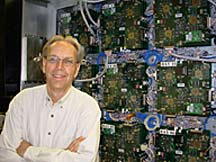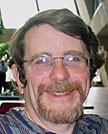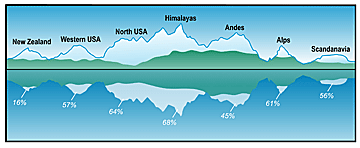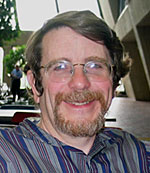| Research
|
|
|||||||||||||||||||||||
|
Check out the Office of Science's new Website.
|
GLAST Software
|
 |
| J. J. Russell and LAT flight software |
Some of nature's most violent processes emit gamma rays. The most energetic form of light, gamma rays come from the hottest regions of the universe including intense supernova explosions, strongly magnetized neutron stars, and powerful jets created by giant, spinning black holes.
Soon a powerful new observatory will orbit the Earth, capturing and tracking these extremely energetic photons. The Gamma-ray Large Area Space Telescope (GLAST) will explore the space's high-energy frontier to help solve the mysteries of dark matter, supermassive black holes, and the evolution of stars.
One important component of GLAST is the Large Area Telescope (LAT), assembled at DOE's Stanford Linear Accelerator Center as part of the NASA-led project. This instrument will record gamma rays at energies greater than any previous space-based mission.
Nearly 350 miles above the Earth's surface, a perpetual storm of particles will bombard the LAT, which in turn will record the path and strength of each particle that strikes. This hail of particle collisions creates 10 megabytes of data every second. Running on a processor about a tenth as powerful as a consumer laptop, computer software will shrink this data down to less than 150 kilobytes per second.
The LAT's flight software will sift through the millions of "events" registered on the instrument's detectors, keeping only those potentially caused by gamma rays.
"To do this without losing information, we have to apply physics knowledge on the fly," says SLAC's Tony Waite, who along with J.J. Russell, led the team that developed the flight software. "We can't just use a standard data compression program like g-zip."
While the craft is in space, researchers will have about an hour of contact with it each day. This will be the only time available for the flight software to transmit the compressed data to Earth.
The flight software configures the LAT to work in two modes: looking at the entire sky to construct a "gamma sky map," or zeroing in on gamma ray bursts, which last anywhere from a few seconds to a few hours.
Physical stresses during launch and exposure to radiation while in orbit will cause changes in the characteristics of the LAT hardware. Some components may fail. To keep the overall system functioning optimally, the flight software constantly recalibrates the hardware and troubleshoots problems.
“We can't climb up with a ladder and stick a probe in the LAT,” says Russell.
The LAT took a 3,000 mile journey from SLAC in California to the U.S. Naval Research Laboratory in Washington, D.C., last month. "We've cleared the Rockies and we're on to the Gamma Rays," said Ev Valle, SLAC's DOE Site Office Federal Project Director. GLAST is expected to launch in 2007.
Submitted by DOE's Stanford Linear Accelerator Center



